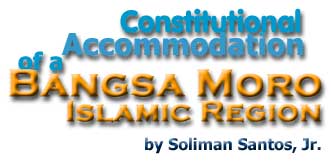|
The
Newsletter |
|
||||
| Moros: JUETENG For
Deliverance? Understanding
The Mindanao Conflict Ethnic Cleansing In
Mindanao
After
Abubakar's Fall: What? Is Federalizing The
Republic The Solution To Mindanao? Constitutional
Accommodation of a Bangsamoro Islamic Region Mindanao Movements Sulu Saxophone Explaining Erap's The Palestinian Intifada Creative Writing Section A Muslim's prayer
for peace Featured Links The
Academy of Natural Sciences Digital
Libraries Bioethics IslamZine Archives The book BUGS & BYTES, In Bigger Prints, is now available at National Book Store outlets in MetroManila and the Universtiy of the Philippines Press Bookshop in Diliman, Quezon City. Support B&B by searching and buying your books & CDs from here.
|
(Soliman M. Santos, Jr. is a lawyer, legislative consultant and peace advocate. This paper is based on his masteral law thesis at the University of Melbourne on Constitutional Accommodation of a Moro Islamic System in the Philippines.)
"Exploring Constitutional Structures for the Muslim Community" is a concisely well-stated theme for this roundtable discussion hosted by the UP Law Center's Institute of International Legal Studies. This is precisely what we should do, explore solutions to the Bangsamoro problem. We know that the Moro Problem and, more so, the broader Mindanao Problem is a complex multi-dimensional holistic problem that needs a complex multi-dimensional holistic solution. The suspended Government of the Republic of the Philippines - Moro Islamic Liberation Front (GRP-MILF) peace negotiations, at least the MILF side, seek foremostly a political solution as the key dimension. But a political solution without a constitutional solution will not go far. There can be no radical political restructuring without constitutional change. The constitutional dimension is very much part of the problem and of the solution. One way of posing the constitutional problem is this: What is the best possible structure for the political relationship between the central Philippine government and for that matter the Filipino people, on one hand, and the Bangsamoro people in the Southern Philippines, on the other hand? Or, is there space, can space be created, in the Philippine republican polity and constitutional system to accommodate a Moro Islamic system of life and governance (the main aspiration represented by the MILF)?
The Mindanao Problem is a problem of relationships among the three peoples (Christian Filipinos, Muslim Moros and indigenous Lumad) there and with the central Philippine government, with the Muslim or Moro Problem as its historically and currently most critical expression, its cutting edge or key link. Recognition of the broader Mindanao context is not incompatible with the necessary focus on the Muslim or Moro Problem to give it its just due, albeit informed by or conscious of Mindanao's tri-people character. The Tri-People Approach emphasizes the existence of the three peoples which have to share Mindanao, the ideal of their equality and unity, and Mindanao itself as the basis of a new or additional identity as Mindanaoan or Mindanawon. But this should not negate Moro and Lumad identities, which are still struggling for better recognition. We seek not just harmony but harmony in diversity. Going back now to the constitutional discourse, our exploration will be helped immensely by international legal studies, particularly on comparative and international law and practice. These studies will reveal a wide range of possibilities, a wide range of "constitutional choices" - between integration and secession (or independence). At both extremes, you have forced integration and forced secession, both attained by a military solution. You can also have free association (integration) and negotiated secession (or independence). But the general categories of integration and secession are not considered desirable or feasible, as the case may be, at present and for the foreseeable future. For example, it is not likely that the Philippine government and even the Organization of Islamic Conference (OIC) and the United Nations (UN) would agree to a referendum on the question of independence even if only in the predominantly Muslim areas in Mindanao. Then, you have the more feasible general categories of autonomy and federalism, each with a wide range of possibilities, models and structures. Autonomy has become somewhat of a bad word, especially in some Moro quarters, because of the generally negative experiences with it since President Marcos first instituted it in 1977/1979 to unilaterally implement the 1976 Tripoli Agreement. The latter called for autonomy for the Muslims in the Southern Philippines as the negotiated political solution to their problem. But the experiences in other countries show that what we have had so far, up to the autonomy envisioned in the 1996 GRP-MNLF Peace Agreement, has not exhausted the possibilities of autonomy for the Muslim community. Some country experiences further show that autonomy can be even more self-determinative than federalism. In other words, autonomy is not necessarily of a lower category than federalism and can sometimes be closer than the latter to independence. Independence or secession, especially if negotiated, should not be ruled out entirely as solutions. But I believe the possibilities of non-independence solutions should be explored and exhausted first before resort to independence solutions. According to one in a series of Cambridge studies in international and comparative law, "Secession cannot be accepted under international law if the grievances underlying the demands for secession can be removed through the exercise of internal self-determination…A high degree of autonomy can legally be demanded by those groups who have a separate right of self-determination. This cannot be refused as long as the territorial integrity of the state is respected…Secession whether leading to independence or to any kind of integration with another State, should only be achieved, in the absence of the consent of the State from which secession is sought, after a period of maximum autonomy." In short, failure to provide such maximum autonomy becomes justifiable cause for secession. If the Philippine constitutional system and the Filipino people cannot accommodate a Moro Islamic system in predominantly Muslim areas which want it, then Moro secession becomes a principal option. The premise here is that the Moro aspiration for an Islamic system, even in its maximum form of an independent Islamic state, is a legitimate aspiration because it goes to the core of cultural diversity: a people's identity, way of life, and longing for self-rule. A case can also be made for Bangsamoro independence on historical, cultural, legal, moral and even religious grounds. Datu Michael O. Mastura, among others, has articulated Moro historic claims and legal rights. But, as we said, let us put off for now the case for independence. At the same time, the Philippine alternative to Bangsamoro independence or an independent Islamic state would have to be as close to it as possible, as good as it gets, to merit acceptability from the Moro side. Low-intensity autonomy which the Moro side can hardly consider as "meaningful," like the "political package" which is HB 7883, will not suffice to satisfy the more Islamic aspirations represented by the MILF, even as it may satisfy likewise legitimate political and economic aspirations of integration represented by the MNLF. To restate the constitutional problem: how do we accommodate a Moro Islamic system of life and governance within the Philippine republic and territory considering the fundamentally opposing constitutional paradigms of the GRP and the MILF? How can such a system find space in a highly centralized presidential-unitary system dominated by a political and economic elite with a Western-Christian orientation? Can the MILF, with its Islamic revivalist orientation and political thinking, accept something less than an independent Islamic state? Can the GRP, with its tradition of constitutionalism, accept the non-practice of the Philippine constitutional system in a special Islamic region within its territory? We have to consider the opposing constitutional paradigms, which partake of the nature of a "clash of civilizations," culture and ideology, and which militate against accommodation on and from both sides: 1.
Constitution vs. Qur'an On the other hand, there are
helpful concepts in the Philippine Constitution and constitutional law which could support
accommodation of a Moro Islamic system: In fact, there are also helpful Islamic concepts or devices which would allow a Muslim minority to reconcile itself with and accept living in a Christian majority state: 1.
Dar al-Sulh (Territory of Peace or Truce) Furthermore, there is initial common ground between the parties which is found in the GRP-MILF "General Framework of Agreement of Intent" of 27 August 1998: 1.
human rights in accordance with the principles in the UN Charter, and the Universal
Declaration of Human Rights (UDHR) Significantly, the human rights approach to self-determination, including to ethnic group claims, is preferred over the historical sovereignty approach, going by recent thinking and trends in international law. In the Western Sahara case, (Advisory Opinion) [1975] ICJ Rep 12, involving the decolonization of Spanish Sahara, the International Court of Justice favored an approach based not on historical communities and ties but on contemporary human interaction and values, by which the future status of the territory would be determined through the free and genuine expression of the will of its contemporary inhabitants. This seems to be echoed in the MILF's Situation Report submitted to the OIC before its last Islamic Conference of Foreign Ministers in June 2000 where it is stated that "It is not practical to consider only the prior right of a people to this Island. The actual situation should be given more weight in the formulation of policies. For this reason, the policy of the MILF vis-à-vis the Christians is: Mindanao belongs to all the peoples, Christians, indigenous tribes, and Muslims, who make this island their home." All told, however, though there are sources of hope in initial common ground and in helpful constitutional and Islamic concepts, these are outweighed by fundamentally opposed paradigms, structures and traditions, including inhospitable judicial tradition. From the Islamic perspective, how can the God-given Qur'an be subordinated to a man-made Constitution, no matter how democratic or progressive? How can the sovereignty of Allah be subordinated to the sovereignty of the people? From the Philippine constitutional perspective, how can the inviolable principle of the separation of Church and State not be violated by Islam as din wa dawla (religion and state)? How can an Islamic system, not even an independent Islamic state, in predominantly Muslim areas of Mindanao govern itself in accord with shari'ah (Islamic law) when the Philippine Constitution specifically and unilaterally provides for an autonomous region in Muslim Mindanao with limited powers and always subject to central unitary authority, including national laws and processes? What then is needed to break through this jam? We need a qualitative leap in rethinking constitutionalism and sovereignty: from modern to contemporary constitutionalism, and from old to new sovereignty. Then, we need key mutual compromises on national sovereignty but not territorial integrity on the part of the GRP, and on independent statehood but not Islamic system on the part of the MILF. Modern constitutionalism refers to the kind developed around two main forms of recognition: the equality of independent, self-governing nation-states and the equality of individual citizens. This language served to exclude or assimilate cultural diversity, especially that of indigenous peoples. It construes the aim of the undifferentiated people as the constitution of a uniform system of government, one national system of institutionalized legal and political authority. Thus, President Estrada in his latest State of the Nation Address said: "We upheld the constitutional principle that the Philippines is one state, one republic, with one government, one military answerable to one commander-in-chief, under one constitution and one flag, in one undivided territory. That is what it is now. That is what it will be forever." On the other hand, there is contemporary constitutionalism, as notably synthesized by Canadian scholar James Tully. The Constitution is reconceived as a form of accommodation of cultural diversity. It is also an activity of intercultural dialogue or multilogue between or among peoples or nations in one country in accordance with three important conventions: mutual recognition, consent, and cultural continuity. These principles guide the negotiations towards just forms of constitutional association. The aim is to accommodate differences in appropriate institutions and similarities in shared institutions. It comes from the historical practice of "treaty constitutionalism" between Aboriginal peoples (the "First Nations") of North America and the British Crown (later, Canada and the U.S.) as equal, self-governing nations resulting in relations of protection and interdependency, not discontinuity and subordination. In the case of the U.S., this became the definitive jurisprudence on US-American Indian relations by way of the landmark 1832 Supreme Court decision in Worcester vs. Georgia (31 US 515). This in turn was later incorporated into Philippine jurisprudence in the likewise landmark 1919 Supreme Court decision in Rubi vs. Provincial Board of Mindoro (39 Phil. 660) where the US policy on American Indians was affirmed to have been adopted for the "non-Christian" tribes (including the Moros) in the Philippines. Old sovereignty refers to the kind centralized in a single locus which is the imagined nation-state. This sovereignty is conceived as permanent, exclusive, comprehensive, absolute, indivisible, inalienable, and imprescriptible. Typical of this is the statement of Sen. Franklin M. Drilon in connection with the NDF threat to terminate peace talks on the issue of VFA and national sovereignty: "The universal principle of national sovereignty is that it is one and indivisible and its powers are exercised by the State." On the other hand, there is new sovereignty, as already recognized by many scholars like Kurt Mills and by at least one notable head of state in Czech President Vaclav Havel. This is a reconceptualization of sovereignty as moving both downward (inward) from the state incorporating both human and peoples' rights, and upward (outward) from the state as we look for ways to respond to the need to protect these rights within a global framework as well as respond to the increasing permeability of borders. There can be diffusion of sovereignty where it is inclusive, shared and disseminated, which divides power in various ways to allow regions, peoples and nations to govern themselves to different degrees. Sovereignty is seen in a new light as the authority of a culturally diverse people to govern themselves by their own laws and ways, free from external subordination. In the 1997 Philippine Supreme Court decision in Tanada vs. Angara (272 SCRA 18) on the constitutionality of Philippine ratification of the WTO Agreement, it was held that state sovereignty cannot be considered absolute because of limitations imposed by the very membership in the family of nations and by treaty stipulations. This recognition of the upward devolution of sovereignty should logically lead to a recognition, whether express or implied, of the downward devolution of sovereignty. From comparative and international law and practice, I have picked out one key concept or model and one key device that may help fashion a constitutional solution to the problem of coexistence of two or more sovereignties in the same territory. First is the "One Country, Two Systems" concept based on certain aspects of the Hong Kong Special Administrative Region vis-à-vis the People's Republic of China which might be applied by analogy, to solve the problem of coexistence of peoples with two very different systems in one country. In Islamic terms, the two systems in peaceful coexistence in one country correspond to dar al-Islam (territory of Islam) and dar al-sulh (territory of peace or truce). One local symbolic example is the "Islamic City of Marawi" within the Philippine Republic. Why not an Islamic region which is substantive and not just symbolic? Second is the treaty device, where a treaty is "a compact formed between two nations or communities, having the right of self-government" (from Worcester vs. Georgia). It would allow an Islamic entity to interface with a constitutional entity as equals. It addresses the Islamic concern for non-subordination of the Qur'an to any national constitution or non-subordination of Allah's sovereignty to any other sovereignty. Muwada'a (treaty) is one helpful Islamic concept. There are treaty precedents and models both in early Islamic history (including treaties entered into by the Prophet Muhammad like the "Constitution of Medina") and in Moro history (33 treaties with foreign powers). A rethinking of constitutionalism and sovereignty should lead to key mutual compromises, as we said, on national sovereignty but not territorial integrity on the part of the GRP and on independent statehood but not Islamic system on the part of the MILF. Then, informed by comparative and international law and practice and by Mindanao's tri-people character, we can create a constitutional structure or space that we might call a Bangsamoro Islamic Region (BI'R, from the Arabic word bi'r for well of water) within the Republic of the Philippines. What follows is a brief description which could also be the wording of a proposed constitutional amendment (with which we need not even touch the rest of the Constitution): There shall be created a special Islamic region to meet the aspiration for a system of life and governance suitable and acceptable to the Bangsamoro people who opt for it. This region shall exercise maximum autonomy with independent legislative, executive and judicial powers under an Islamic system, as the Philippine constitutional system shall not be practiced there. This region shall be established pursuant to a peace agreement which shall have constitutional status as defining, among others, the relations of constitutional association between the region and the Bangsamoro people, on one hand, and the Republic and the Filipino people, on the other hand. The constitutional arrangements shall include personal or cultural autonomy for Moros outside the region, and guarantees for the protection of human rights. Among the special considerations for this constitutional arrangement are upholding national unity and territorial integrity, securing the blessings of cultural diversity and lasting peace, and taking account of the history and realities of Mindanao. The BI'R would have a very high degree of autonomy, except for national defense, foreign affairs and possibly currency. The governing law in this highly autonomous Islamic region would be shari'ah to the fullest possible extent. The Qur'an, as the first primary source of shari'ah, would be the real constitution of the BI'R. The Qur'anic blueprint covers all aspects of a whole way of life but Islamic governance is the most crucial aspect of an Islamic system. In addition to the human rights regime under shari'ah, including the status of the dhimmis (non-Muslim minorities), the initial common ground of commitment to protect and respect human rights in accordance with the UN Charter's principles and the UDHR should be carried through and eventually cover other international human rights standards, ideally with a unified approach to human rights which covers both individual and collective rights. Aside from common terms of reference which should include human rights and other generally accepted principles of international law, and aside from mechanisms for dispute resolution in cases of conflict of laws and jurisdiction, the constitutional negotiations should also determine relations of interdependency, cooperation and even protection between the BI'R and the RP. A highly autonomous Islamic system need not be an enclave unto itself within the Philippine polity. A fair interaction is still the best policy for mutual benefit from cultural diversity. The BI'R can be established whether the Philippines remains unitary or goes federal. Be that as it may, autonomy has certain advantages compared to federalism. Basically, autonomy is more purposively addressed to the particularities of an ethno-cultural region, including serving as a conflict-solving mechanism, while federalism applies across the whole country as a national structure - which makes it really another debate. Autonomy is, therefore, more flexible, with a wide range of options from minimum to maximum, up to just short of full independence. It can also assume a personal nature, as in personal or cultural autonomy, while federalism is always territorial and functional. Autonomy's flexibility also extends to the instrument of creation such as a constitution, statute, treaty or a combination of these, while federalism is usually created only by a constitution. Which brings us to the concluding portion of this paper. Assuming that the GRP-MILF peace negotiations be saved and eventually succeed in arriving at a peace agreement which provides, among others, for a special autonomous Islamic region with constitutional status, how is this to be established? How
is the corresponding constitutional amendment to be made? There should perhaps be prior or simultaneous
constitutional amendments to allow for special procedures in amending the constitution
where ethno-religious minorities are concerned, considering that these minorities will always be outvoted
in a national plebiscite. The
recent poll surveys showing President Estrada's popularity for his "all-out war"
against the MILF do not inspire confidence in the prospective vote of the "broad
masses of the people." Mindanao historian Rudy B. Rodil says, "The present form of democracy in the country, the democracy of number as in one- man vote, has been found to be detrimental to the basic interests of the Moro and Lumad communities. We should seriously explore other models of political decision-making. Smaller groups should not be drowned in the name of democracy." Perhaps, a referendum on the question of an Islamic system in predominantly Muslim areas as the unit of self-determination, reckoned down to the barangay level, would be fair enough as a democratic and constitutional process. In this regard, Atty. Carpio asks, "What, for instance, should be the just, fair, and sustainable proportion of predominance that would enable a political unit to be denominated the 'Islamic Region of Southern or Western or Central Mindanao'? (As in 'Islamic City of Marawi')" This becomes a question of tri-people demography and geography, including possible territorial or spatial configurations for the two Moro streams represented by the secular modernist MNLF and the Islamic revivalist MILF. Perhaps, there should be two autonomous regions for the two Moro streams which represent different but complementary Moro aspirations. If so, how would the special Islamic region relate with the (new) ARMM constitutionally and territorially? Should the process for the establishment of a special Islamic region be "gradual and applied in stages" with a progressively increasing "Islamic angle," a "gradual implementation of an expanding shari'ah," as Commissioner Mehol K. Sadain proposes as a solution to the Mindanao conflict? Or should we have two levels (e.g. "low" and "high") of shari'ah now but in different Muslim areas? In fine, there are the dimensions of time as well as of space. All told, there are alternative approaches
towards structural changes for the Muslim community. There are alternative constitutional structures
and spaces for an Islamic system of the Bangsamoro people. These must be fully explored in
order to prepare a constitutional solution in confluence with the necessary
political will and social goodwill that will make it happen.
|
||||
| . | Copyright © 1999 - 2001 |
||||



 Before going further and
deeper into this, just a note about the thematic focus on the Muslim community or the
Bangsamoro people, if you will.
Before going further and
deeper into this, just a note about the thematic focus on the Muslim community or the
Bangsamoro people, if you will.